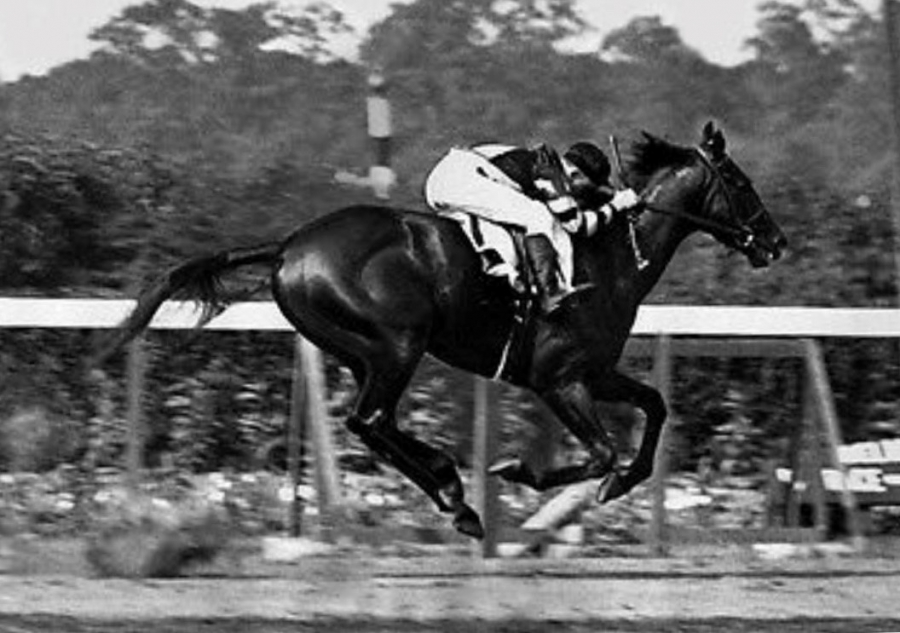WHAT’S IN A NAME
The first thing that comes to mind when one hears the name War Admiral, are likely the great Naval leaders of history. The courageous Horatio Nelson and the charismatic Sir David Beatty are among them. America’s counterparts to these great British Admirals include Raymond Spruance known for his nerves of steel and “William Halsey, aptly nicknamed “Bull” who feared nothing. The attributes mentioned above would be hallmarks in the career of today’s subject.
When it comes to horse racing the name is universally renowned as a great thoroughbred champion. He was sired by the immortal Man O’ War in the year of 1934. This weanling was going to make his father proud. They shared the same ownership. Samuel Riddle had struck the mother load for a second time. From 1936 until his last season 1939, he was to thrill racing fans across the country. He wasn’t equipped with the size of his daddy, standing only a bit over fifteen hands. That being said, he was about to take the celebrated silks of black with yellow hooped sleeves to dizzying heights.
A STAR IN THE MAKING
War Admiral made his way onto the racetrack in the Spring of 1936. It was at the fabled Havre de Grace course in northern Maryland. There he broke his maiden by a nose in a hard fought race. Then it was on to Belmont. In an allowance event, he took a stroll in that Park notching his second win. After a game place finish in his first stakes try, he was back at “The Graw” where he romped home the winner in the Eastern Shore Handicap. Then he finished second in his last rookie start. War Admiral had shown flashes of brilliance in 1936. He was poised to make 1937 one for the ages.
IT WAS A VERY GOOD YEAR
He opened his sophomore campaign with two easy scores on familiar ground at Havre de Grace. Now the Admiral was about to take a train ride...The destination: Louisville. In his sights, America’s greatest horse race, the Kentucky Derby. It may seem, looking back that it was a no brainer he would run in the Derby. At the time this was not the case. Sam Riddle had kept his sire Man O’ War out of the race for various reasons. Foremost, he felt that it was too early in the year for a colt to go ten furlongs. Unfortunately, it cost the great Champion the Triple Crown as he took the Preakness and Belmont easily. It was horse racing’s luck that Riddle had a change of heart seventeen years later. War Admiral was made the favorite for the Derby and easily bested a twenty-horse field. Now it was on to Baltimore where he took the measure of his nemesis Pompoon and added the Preakness to his resume. It was at Belmont Park that he proved just how great he was. Never at home in the starting gate, he almost went down leaving it. He took a large chunk out of his front right hoof and looked like he was heading for disaster. This son of Man O’ War had other plans. Not only did he win the Belmont, he took it easily. In so doing he broke his father’s track record for the mile and a half event. Add to that, he had become America’s fourth Triple Crown Champion. War Admiral wasn’t finished. He won every start the rest of the way that year. He had gone unbeaten and was named Horse of the Year for 1937.
ALL ROADS LEAD TO PIMLICO
This part of the story has been told countless times. The Year was 1938. The United States was amid the Great Depression. Hitler was on the march in Europe. The public needed a break from the realities of a world in turmoil. Two great thoroughbred racehorses at the top of their game were about to give them just that.
ENTER SEABISCUIT
Seabiscuit’s career started quite different from his Uncle, War Admiral’s. You read that right.
In an odd quirk, although War Admiral was a year younger than Seabiscuit, the latter’s grand sire was Man O’ War, which made him the Admiral’s nephew. As a two-year-old he was entered in low level claiming races. He found no success there. In fact, he didn’t find the winner’s circle until his eighteenth start. He slowly began to evolve. It was in 1937 at age of four that he hit his stride. He won ten stakes races from one end of the country to the other. In four of those tallies he set track records. Now the chatter started. Who was better? Was it Seabiscuit with his stellar campaign or War Admiral, a Triple Crown winner and an unbeaten season. 1938 came and the Admiral was on a roll. He took the Widener at Hialeah. Then he headed north. He came up short in a stakes race at Suffolk Downs ending his eleven-race win streak. Here at the venerable Spa he regained form. He took four stakes races here including the Whitney and Saratoga Cup. Seabiscuit, too was on fire. He took his road show on a coast to coast tour, winning stakes races all over the country. It was now inevitable that the two were on a collision course. It was just a matter of when and where.
ENTER ALFRED G. VANDERBILT
Heir to the Vanderbilt fortune, sportsman, thoroughbred owner and racetrack entrepreneur. This was Alfred G Vanderbilt. He, at the time owned Pimlico Race Track. When a 100,000 dollar winner take all race fell through at Belmont Park, Vanderbilt worked on his plan. He would offer a 15,000-dollar purse at the Preakness distance of a mile and three sixteenths with even weights. Both owners accepted. Mr. Vanderbilt for the paltry sum of 15,000 dollars had tucked the “Race of the Century” into his back pocket.
CLASH OF TITANS
The race was on. It was to be contested at Pimlico on November first, 1938. Both horses would be in the hands of two of the best race riders in the country. Charlie Kurtsinger had the mount on War Admiral. George “The Iceman” Woolf would be on board Seabiscuit. The event was preceded by the utmost coverage in newspaper columns and radio programs from stations all over the country. Sports fans nationwide were holding their breath in excitement. Forty million Americans tuned in on their radio stations on race day. The Great War Admiral was made the odds-on favorite by the forty thousand fans in attendance. The two gladiators pranced onto the racetrack at approximately five o’ clock in the afternoon. The track was listed as fast. The old style walk up was used to start the race. The Iceman quickly got Seabiscuit to a two-length lead. When they hit the clubhouse turn War Admiral was neck and neck with him. The two stayed that way down the backstretch and into the far turn. The legendary race announcer Clem McCarthy barking in his distinctive raspy, cigar smoke voice could not separate them. Then, at the top of the stretch the great Admiral began to crack. Seabiscuit started to draw away. At the finish line he was clear by four. Seabiscuit had taken the measure of the invincible War Admiral. Fans across the country were stunned. They never met again. War Admiral was retired after one race as a five-year-old. Seabiscuit raced on until 1940. In his final start he took California’s most important race, the Santa Anita Handicap. Eighty years have passed since the “Race of the Century” was contested. Yet it lives on as one of the greatest sporting events in American history.
WHO WAS THE BETTER HORSE?
As I have stated in the past, match races have a tendency to prove nothing. There is always a tremendous amount of hype leading into the race. The winner in virtually all of them is the horse that jumps to the early lead. He then has a tremendous advantage over his rival. Can Seabiscuit be compared to War Admiral? The answer can be found in their past performances. Other than the match race loss, War Admiral did everything a great thoroughbred is capable of.
Seabiscuit did win thirty-three races. On the other hand, he was beaten no less than fifty-six times. Was he the better horse that day? Without doubt, that is a fact. He is also a horse that had a folklore style career. His name is known to anyone familiar to the sport. This does not put him in the same class of War Admiral. The Admiral, though diminutive in size, will forever stand tall with his immortal sire Man O’ War in the Pantheon of Champions.






































